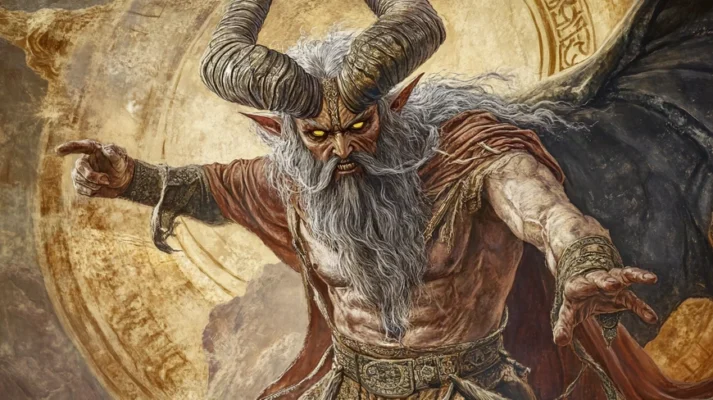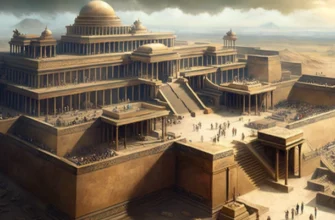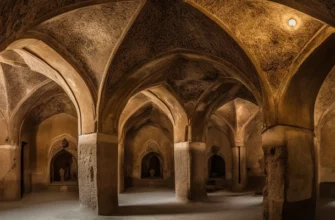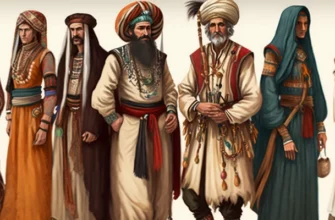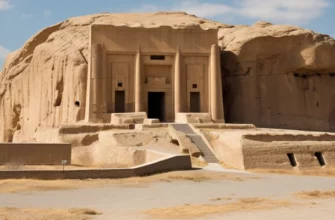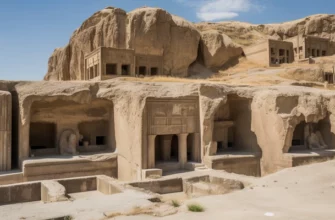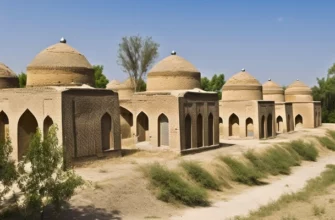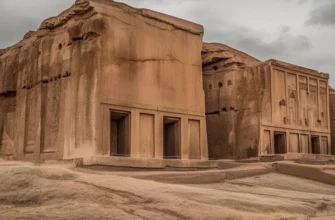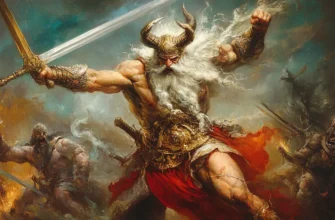Ahriman, also known as Angra Mainyu, is an evil spirit in Zoroastrianism, one of the oldest religions of Iran. He probably originates from an early Indian tradition, where his counterparts act as demonic forces. In Zoroastrianism, Ahriman is the main antagonist of Ahura Mazda, the supreme god of light and goodness.
Ahriman symbolizes darkness, chaos, and evil forces. His main role is to oppose the order and harmony that Ahura Mazda represents. In Zoroastrian cosmogony, Ahriman is the source of all evil and negativity in the world, opposing divine light and truth. This opposition forms the main conflict in the religious cosmology and moral system of this faith.
In culture, Ahriman is depicted as a dangerous and powerful adversary who influences the moral and spiritual beliefs of believers. He is often mentioned in classical texts and religious works, where his influence on human affairs is a topic for reflection and learning.
Ahriman continues to be an important symbol in understanding the struggle between good and evil, leaving a mark on the culture and religious traditions not only of Iran but also beyond its borders.
The significance of Ahriman in Zoroastrianism
In Zoroastrianism, Ahriman, or Angra Mainyu, is the embodiment of evil and the antithesis of Ahura Mazda, the god of light and goodness. His role and significance in this religion can be considered through several key aspects:
Opposition to Good: Ahriman is the main opponent of Ahura Mazda in the cosmogony of Zoroastrianism. His activities are aimed at undermining the order and harmony established by Ahura Mazda. This opposition forms the main conflict in the religious cosmology and moral system of Zoroastrianism.
Nature and Influence: Ahriman embodies darkness, chaos, disorder, and all negative forces in the world. He not only acts as an individual antagonist, but also symbolizes all forms of evil that oppose divine order and truth.
Cosmogonic Conflict: According to Zoroastrian cosmogony, Ahriman and Ahura Mazda are in a constant struggle for control of the world. Ahriman creates illusions, filth, disease, and conflict that attempt to distract humanity from the true noble life.
Moral Dialectic: Ahriman also represents the moral choices that people face. The choice between good (represented by Ahura Mazda) and evil (represented by Ahriman) is central to the religious practice and ethics of Zoroastrianism. People are called upon to actively fight against evil and support good deeds to maintain harmony in the world.
End of Days: In Zoroastrianism, there is a belief in the ultimate victory of good over evil. Ahriman and his forces will eventually be defeated, and the world will return to the ideal state of harmony and light in which it was originally created.
Thus, Ahriman is an important part of the Zoroastrian religion, helping to define the moral and philosophical foundations of the faith.
The origin and role of Ahriman
Ahriman, or Angra Mainyu, is a central figure in Zoroastrianism, one of the oldest religions of Iran. His origin is probably linked to Indo-European beliefs, where he has parallels with Indian demonic beings such as the Asuras. In Zoroastrianism, Ahriman acts as the antagonist of Ahura Mazda, the supreme god of light and goodness.
Ahriman’s role is to embody evil, darkness, and chaos. He is the source of all negative forces that undermine the moral and cosmic order established by Ahura Mazda. In Zoroastrian cosmogony, the universe is in a constant struggle between good and evil, and Ahriman, as the leader of the forces of evil, actively seeks to disrupt harmony and order.
Followers of Zoroastrianism must actively fight against the influence of Ahriman by upholding moral principles and doing good deeds. This is part of their duty to maintain light and order in the world. According to the faith, a time will come when Ahriman and his forces will be finally defeated, and the world will return to its original state of harmony and purity. This ultimate victory of good over evil is an important part of the Zoroastrian faith.
Mythological origins
The mythological origins of Ahriman, or Angra Mainyu, are rooted in early Iranian and Indo-European beliefs. In Zoroastrianism, which took shape around the 6th century BCE, Ahriman is a central figure who embodies evil and chaos.
He comes from ancient Iranian beliefs, where his counterparts have parallels with Indian demonic beings, particularly the Asuras. These beings in Indian mythology symbolize darkness and evil, opposing the Devas, the forces of good and light. Also, in earlier Iranian traditions, Ahriman reflects the struggle between order and chaos.
In Zoroastrianism, Ahriman appears as the absolute antagonist of Ahura Mazda, the supreme god of light and wisdom. This concept of the opposition between good and evil is central to Zoroastrian cosmology. It is likely that such mythological ideas about the struggle between the forces of light and darkness developed on the basis of ancient Indo-European myths adapted to the Iranian context. In this context, Ahriman becomes the embodiment of everything negative and destructive in the world, opposing the divine order established by Ahura Mazda.
Main attributes and symbols
Ahriman, or Angra Mainyu, has several main attributes and symbols that help to understand his role in Zoroastrianism.
Attributes:
Darkness and Chaos: Ahriman personifies darkness, chaos, and everything that opposes the order and light represented by Ahura Mazda. His attributes include dark forces and negative energies that undermine the harmony of the universe.
Demonic Forces: As the embodiment of evil, Ahriman is associated with various demonic forces and beings that are characterized by their destructive and negative nature. He has numerous servants and accomplices who assist him in his malicious plans.
Images and Symbols: Ahriman is often depicted as an aggressive and dark figure who carries destructive power. He can be symbolized by images of darkness, evil creatures, or evil in the form of burning fire or a snake, which symbolizes deception and treachery.
Symbols:
Snakes: Snakes or other similar creatures can be symbols of Ahriman, reflecting his cunning and malice. In many myths, snakes are associated with negative forces and evil.
Fire: Ahriman can be symbolized by fire, but not as a fire that brings light and warmth, but as a destructive fire that burns and destroys.
Shadows and Darkness: In art and religious texts, Ahriman is often associated with shadows and darkness, reflecting his role as the source of all that is evil and chaotic in the world.
These attributes and symbols help convey the essence of Ahriman as an antagonist in Zoroastrian cosmology, where his activities oppose the divine order and moral light represented by Ahura Mazda.
Ahriman in Culture and Literature
As a central figure in Zoroastrian mythology, Ahriman has had a significant influence on the culture and literature of various eras and regions. His image has often been used to represent concepts of evil and conflict, and his influence can be traced in several major areas:
Classical Texts and Religious Literature: In classical Zoroastrian texts such as the Avesta, Ahriman is a key figure. These texts describe him as the antagonist of Ahura Mazda, creating conflict between good and evil. In Zoroastrian literature, his role in the cosmogonic struggle defines many aspects of religious practice and moral teachings.
Influence on Islamic and Christian Traditions: The image of Ahriman influenced the development of the idea of evil in later religious traditions. In some Islamic and Christian texts, parallels can be found to concepts of evil and darkness that have their roots in Zoroastrianism. Although direct connections are not always obvious, ideas derived from Ahriman may have influenced religious conceptions of demonic forces.
Medieval Literature and Art: In medieval literature and art, Ahriman was often depicted as the embodiment of evil and demonic forces. His images were used to symbolize moral and cosmic conflicts, reflecting the struggle between good and evil. These images often served to convey ethical lessons and morals.
Contemporary Culture: In contemporary culture, Ahriman continues to be an important symbol. His image appears in fiction, cinema, and video games, where he often represents antagonistic forces. Contemporary works may adapt his role to reflect modern social and moral issues, while retaining his core attributes of evil and chaos.
Popular Culture: Ahriman also appears in popular culture, where his image can be adapted for various art forms, such as films, comics, and video games. In these contexts, he is often presented as a powerful enemy opposing heroes or forces of good.
Thus, Ahriman’s influence on culture and literature is significant and diverse, ranging from classical religious texts to contemporary media. His image as the embodiment of evil and chaos continues to be an important part of human cultural and literary heritage.
Ahriman in contemporary culture
Ahriman, as a character in Zoroastrian mythology, has an interesting reflection in contemporary culture, where his image has been adapted and reinterpreted in various media and genres.
Literature: In contemporary literature, Ahriman often appears as a symbol of evil or antagonistic forces. Well-known authors may use his name or concept to create images of dark forces opposing the heroes. In some cases, he may serve as a metaphor for internal or social conflicts.
Cinema: In cinema, Ahriman may appear as a character or concept that poses a threat to the main characters. Films that explore themes of the struggle between good and evil sometimes use elements of Zoroastrian mythology, including images reminiscent of Ahriman, to create dramatic antagonistic figures.
Video games: Video games often use mythological figures to create enemies or antagonists. Ahriman or similar characters may appear as powerful adversaries that players must overcome. He may be represented as a powerful demonic force or an evil overlord seeking to destroy the world.
Comics and graphic novels: In comics and graphic novels, Ahriman can be adapted as a supervillain or negative character with powerful dark forces. He is often depicted as a mythical or fantastical antagonist, adding tension and drama to the plot.
Pop culture and media: Ahriman can also be referenced or alluded to in modern media, such as television shows, music, or online content. His image is used to create symbolic or allegorical themes related to the struggle between good and evil.
Thus, in modern culture, Ahriman often functions as a symbolic image of evil, allowing creators to depict and explore conflicts, moral dilemmas, and themes of struggle. His constant presence in various art forms testifies to his enduring influence and significance even in a modern context.
Conclusions
The Iranian god Ahriman is a key figure in Zoroastrianism, playing an important role in shaping the religious and cosmological system of this ancient faith. As the embodiment of evil and chaos, Ahriman opposes Ahura Mazda, the god of light and goodness, creating the fundamental conflict between good and evil in Zoroastrian mythology. His image, origins, and attributes, such as darkness, chaos, and demonic forces, were influential in shaping the moral and religious ideas of the ancient Iranians.
Throughout history, Ahriman has also influenced other religious and cultural systems. His concept as an antagonistic force of evil finds parallels in later religions such as Islam and Christianity, where similar ideas about evil forces and demonic adversaries helped shape ideas about the struggle between good and evil. Ahriman continues to be significant as a symbolic image of evil, helping to shape cultural and religious narratives.
In the modern context, Ahriman continues to have a significant influence on religious and cultural ideas. His image is often adapted in literature, cinema, video games, and other art forms, where he represents antagonistic forces and sinister powers that oppose heroes and forces of good. This influence helps to explore and represent contemporary themes of conflict, morality, and evil.
Ahriman also serves as a symbolic element for understanding contemporary social and cultural issues. His image can be used to reflect the internal and external conflicts that people face in the modern world, as well as to analyze moral and philosophical questions that are relevant to contemporary society.
Overall, Ahriman is an important part of cultural and religious heritage, and his influence on contemporary ideas about good and evil testifies to his enduring relevance and significance in human history and culture.
